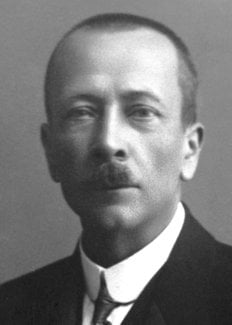Fritz Pregl
Biographical

Fritz Pregl was born in Laibach* on September 3, 1869, and attended the local “Gymnasium” (grammar school), from where he proceeded to the University of Graz to study medicine. He received his M.D. in 1894, but even prior to graduation he became assistant lecturer for physiology and histology under Alexander Rollett, taking over the chair when Rollett died in 1903. During this time Pregl also acquired a thorough knowledge of all branches of chemistry under the guidance of Professor Skraup.
In 1904 he went to Germany, where he studied for short periods under Gustav v. Hüfner in Tübingen, W. Ostwald in Leipzig and Emil Fischer in Berlin. On his return to Graz in 1905 Pregl worked at the Medico-Chemical Institute under K.B. Hofmann and was appointed forensic chemist for the Graz circuit in 1907. At that time he started investigating the components of albuminous bodies and the analysis of bile acids. His work, however, was handicapped by the lack of sufficient starting materials and this fact impelled him to look for methods requiring smaller amounts when making quantitative analyses of elements in compounds.
The years 1910-1913, whilst professor at Innsbruck University, were almost entirely devoted to developing the method of quantitative organic micro-analysis. Pregl continued with this work when he was recalled to Graz University in 1913; he was appointed Dean of the Medical Faculty for the year 1916-1917 and Vice-Chancellor of Graz University for 1920-1921.
Initially Pregl’s scientific work had been mainly in the fields of physiology and physiological chemistry; later he turned to the study of the constitution of chemical compounds, in particular the investigation of bile acids. By 1912 he was able, by using his own methods of quantitative micro-analysis, to make measurements of carbon, hydrogen, nitrogen, sulphur, and halogen, using only 5-13 mg of starting materials with results as accurate as those obtained by macro-analysis. Later he perfected his techniques so that as little as 3-5 mg were adequate. Pregl also contributed a number of micromethods for measuring atomic groups and developed a series of apparatus, including a sensitive microbalance, necessary for his work.
Recognition for his work was first accorded with the Lieben Prize for Chemistry from the Imperial Academy of Science in Vienna (1914), an honorary doctorate in philosophy from the University of Göttingen (1920 ); in 1921 he was elected Corresponding Member by the Academy of Sciences in Vienna. The greatest and most unexpected honour was the award of the Nobel Prize for Chemistry by the Swedish Academy of Sciences in 1923. O. Hammarsten, the Chairman of the Nobel Committee at the time, pointed out that it was not for a discovery, but for modifying and improving existing methods that Pregl was awarded the prize.
Pregl had, in the early stages of his investigations, avoided publishing individual reports on his experiments, until he had convinced himself that his methods did not only work in his own, but also in other laboratories. He then, in 1917, set down his findings in a monograph entitled Die quantitative Microanalyse (published by J. Springer, Berlin). A second edition was published in 1923 and a third revised and enlarged edition (256 pages) appeared in 1930. Later editions were revised by Dr. H. Roth. The seventh edition was published in 1958 by Springer in Vienna. Pregl’s monograph has also been translated into French and English.
Following the award of the Nobel Prize for Chemistry in 1923, chemists from all over the world came to the Medico-Chemical Institute in Graz to study Pregl’s techniques of quantitative organic micro-analysis under his guidance.
Pregl never married, and died after a short illness at the age of 61 at Graz on December 13, 1930. Shortly before his death he put a considerable amount of money at the disposal of the Vienna Academy of Sciences for the promotion of micro-chemical research, stipulating that the interest from this fund was to be used each year to award a prize for outstanding work to Austrian micro-chemists. Since then, the Vienna Academy of Sciences has awarded this prize as the “Fritz Pregl Prize”.
This autobiography/biography was written at the time of the award and first published in the book series Les Prix Nobel. It was later edited and republished in Nobel Lectures. To cite this document, always state the source as shown above.
The Nobel Foundation's copyright has expired.Nobel Prizes and laureates
Six prizes were awarded for achievements that have conferred the greatest benefit to humankind. The 14 laureates' work and discoveries range from quantum tunnelling to promoting democratic rights.
See them all presented here.
